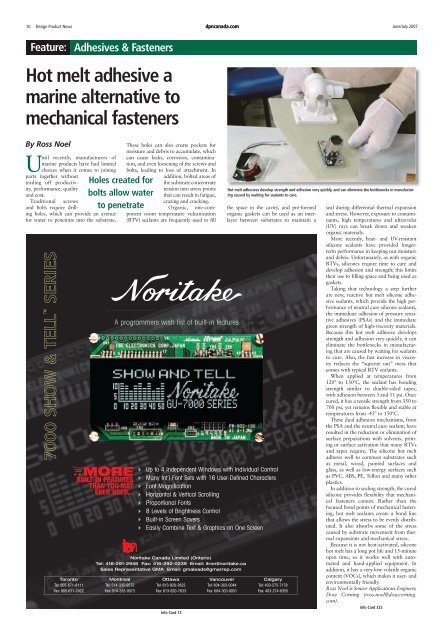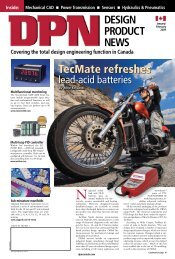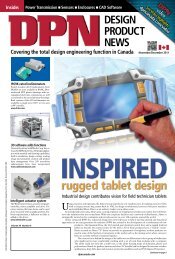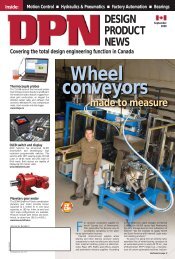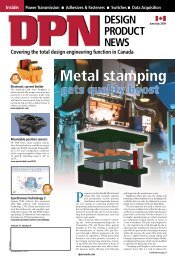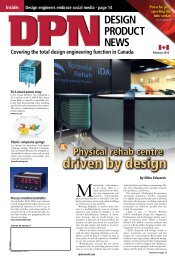DesIgn ProDuCT news - DPN Staff
DesIgn ProDuCT news - DPN Staff
DesIgn ProDuCT news - DPN Staff
Create successful ePaper yourself
Turn your PDF publications into a flip-book with our unique Google optimized e-Paper software.
10 Design Product News<br />
dpncanada.com June/July 2007<br />
Feature: Adhesives & Fasteners<br />
Hot melt adhesive a<br />
marine alternative to<br />
mechanical fasteners<br />
By Ross Noel<br />
Until recently, manufacturers of<br />
marine products have had limited<br />
choices when it comes to joining<br />
parts together without<br />
trading off productivity,<br />
performance, quality<br />
and cost.<br />
Traditional screws<br />
and bolts require drilling<br />
holes, which can provide an avenue<br />
for water to penetrate into the substrate.<br />
<br />
<br />
<br />
<br />
Holes created for<br />
bolts allow water<br />
to penetrate<br />
<br />
<br />
<br />
<br />
<br />
<br />
<br />
<br />
These holes can also create pockets for<br />
moisture and debris to accumulate, which<br />
can cause leaks, corrosion, contamination,<br />
and even loosening of the screws and<br />
bolts, leading to loss of attachment. In<br />
addition, bolted areas of<br />
the substrate concentrate<br />
tension into stress points<br />
that can result in fatigue,<br />
crazing and cracking.<br />
Organic, one-component<br />
room temperature vulcanization<br />
(RTV) sealants are frequently used to fill<br />
<br />
<br />
<br />
<br />
<br />
<br />
<br />
<br />
<br />
<br />
<br />
<br />
<br />
<br />
Info Card 13<br />
<br />
<br />
<br />
Hot melt adhesives develop strength and adhesion very quickly, and can eliminate the bottlenecks in manufacturing<br />
caused by waiting for sealants to cure.<br />
the space in the cavity, and pre-formed<br />
organic gaskets can be used as an interlayer<br />
between substrates to maintain a<br />
<br />
<br />
<br />
seal during differential thermal expansion<br />
and stress. However, exposure to contaminants,<br />
high temperatures and ultraviolet<br />
(UV) rays can break down and weaken<br />
organic materials.<br />
More recently, heat- and UV-resistant<br />
silicone sealants have provided longerterm<br />
performance in keeping out moisture<br />
and debris. Unfortunately, as with organic<br />
RTVs, silicones require time to cure and<br />
develop adhesion and strength; this limits<br />
their use to filling space and being used as<br />
gaskets.<br />
Taking that technology a step further<br />
are new, reactive hot melt silicone adhesive<br />
sealants, which provide the high performance<br />
of neutral cure silicone sealants,<br />
the immediate adhesion of pressure sensitive<br />
adhesives (PSAs) and the immediate<br />
green strength of high-viscosity materials.<br />
Because this hot melt adhesive develops<br />
strength and adhesion very quickly, it can<br />
eliminate the bottlenecks in manufacturing<br />
that are caused by waiting for sealants<br />
to cure. Also, the fast increase in viscosity<br />
reduces the “squeeze out” mess that<br />
comes with typical RTV sealants.<br />
When applied at temperatures from<br />
120º to 130ºC, the sealant has bonding<br />
strength similar to double-sided tapes,<br />
with adhesion between 3 and 11 psi. Once<br />
cured, it has a tensile strength from 350 to<br />
700 psi, yet remains flexible and stable at<br />
temperatures from -45º to 150ºC.<br />
These dual adhesion mechanisms, from<br />
the PSA and the neutral cure sealant, have<br />
resulted in the reduction or elimination of<br />
surface preparations with solvents, priming<br />
or surface activation that many RTVs<br />
and tapes require. The silicone hot melt<br />
adheres well to common substrates such<br />
as metal, wood, painted surfaces and<br />
glass, as well as low-energy surfaces such<br />
as PVC, ABS, PE, Teflon and many other<br />
plastics.<br />
In addition to sealing strength, the cured<br />
silicone provides flexibility that mechanical<br />
fasteners cannot. Rather than the<br />
focused bond points of mechanical fastening,<br />
hot melt sealants create a bond line<br />
that allows the stress to be evenly distributed.<br />
It also absorbs some of the stress<br />
caused by substrate movement from thermal<br />
expansions and mechanical stress.<br />
Because it is not heat-activated, silicone<br />
hot melt has a long pot life and 15-minute<br />
open time, so it works well with automated<br />
and hand-applied equipment. In<br />
addition, it has a very low volatile organic<br />
content (VOCs), which makes it user- and<br />
environmentally friendly.<br />
Ross Noel is Senior Applications Engineer,<br />
Dow Corning (ross.noel@dowcorning.<br />
com).<br />
Info Card 325


